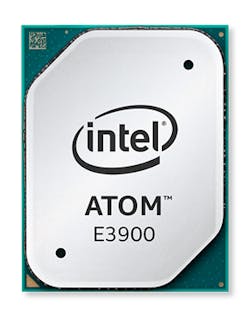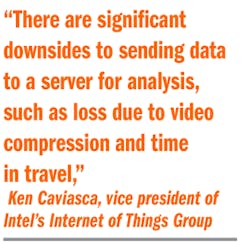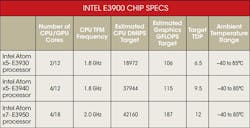For the last quarter century, Intel’s brand has morphed into a household name. But in recent years, the chipmaker has increasingly bent toward a future in which its computer chips are largely anonymous.
The Santa Clara-based company has sold vast quantities of server chips to Silicon Valley neighbors like Google and Facebook. It has tuned its computers to make them useful in cars, drones, and factories. Intel has also acquired machine vision start-ups like Movidius, whose chips silently watch their surroundings from inside security cameras.
Intel continued on that route Tuesday when it announced its latest Atom chip, which will provide almost twice the performance than a previous generation of chips for industrial computers, automotive displays, and cameras.
The new chip, E3900, is the chipmaker’s latest venture into the kinds of power-sipping chips that dominated smartphones and could breathe life into the Internet of Things. The chip also shoulders Intel into an embedded market with competition ranging from entrenched chipmakers like Marvell to newcomers like Qualcomm, which recently tweaked its popular Snapdragon processors for robotics and smart watches.
Ken Caviasca, a vice president of Intel’s Internet of Things Group, said in a brief interview that the new chip would stand out by providing more computing power to individual sensors. That enables cameras, for example, to get started on tricky tasks like identifying objects in pictures before shifting more complicated work to the cloud.
The improvements in the E3900 chip can be traced to its infinitesimal circuitry. In contrast to the earlier E3800 line, which was released in 2013 with transistors measuring 22 nanometers, the new chip is based on Intel’s Goldmont architecture, which uses silicon wires only 14 nanometers long.
The new Atom chip is devised with up to four computing cores and Intel’s latest generation of graphics. It supports tougher security, enhanced I/O capabilities, and a broader range of operating systems, including machine vision software. The power consumption comes in between 6.5 and 12 watts, with an ambient temperature range of -40 to 85°C.
The fate of Intel’s Atom brand was uncertain only several months ago. In April, Intel revealed that it had discontinued its line of smartphone processors and several reports prematurely declared that its Atom products would be canceled. But instead that decision cleaned the slate for Atom, which Intel refocused on growing markets for industrial computers and cameras.
The E3900 delivers almost three times the graphics capabilities of Intel's previous embedded chips. It contains four image processing units, allowing it to prepare sharper and more colorful images for machine vision algorithms. Itseez, a machine vision start-up that was recently acquired by Intel, is working on specialized software for the E3900, said Caviasca.
The hardware also includes what Intel calls time-coordinated computing, which synchronizes clocks across an entire network of connected devices. It achieves timing accuracy within a microsecond for automotive cameras and the programmable logic controllers used in factory equipment.
On Tuesday, Intel also announced the A3900 chip, which is designed for digital gauges and dashboard displays in cars. It will be available in the first half of 2017, the company said, with an extended temperature range to 110°C.
The timing of the announcement, which came at the Internet of Things Solutions World Congress in Barcelona, Spain, is also significant. It coincides with the first day of ARM TechCon, an annual conference in Santa Clara for chips based on ARM blueprints, whose success in smartphones has made them an Internet of Things darling.
But Intel has defended the early success of its IoT business. The company said that samples of the new Atom chip have already lured partnerships with auto part makers like Delphi and China’s FAW, and security camera companies like Hikvision. Almost 30 customers are already using the E3900, it said.
About the Author
James Morra
Senior Editor
James Morra is the senior editor for Electronic Design, covering the semiconductor industry and new technology trends, with a focus on power electronics and power management. He also reports on the business behind electrical engineering, including the electronics supply chain. He joined Electronic Design in 2015 and is based in Chicago, Illinois.





